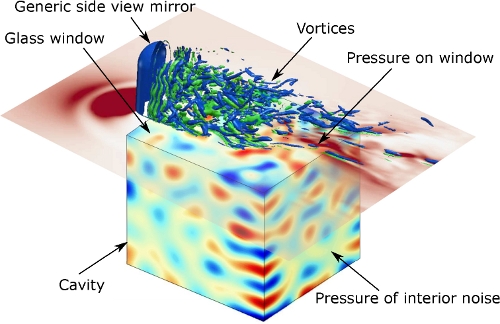 |
|
|
| Researcher: |
Hua-Dong Yao huadong@chalmers.se |
| Supervisor: |
Lars Davidson lada@chalmers.se |
| Cooperation: |
AB Volvo, Zenitha Chroneer zenitha.chroneer@volvo.com |
| Sponsors: | The Swedish Energy Agency, FFI |
| Publications: | [1-4] |
| Start of project: | December 2014 |
| End of project: | December 2018 |
BACKGROUND A quiet cabin environment is a common concern of automotive and aeronautic industries to manufacture high-class productions in consideration of comfort. Besides, long-term exposure to a noisy environment might render health problems, e.g., psychological disorder and hearing loss. Turbulent flows are known as an important contributor to interior noise in truck cabins at cruising speeds between 80 and 90 kph. Besides, the flow-induced interior noise is more significant for trucks with hybrid and full electric propulsion systems, where another noticeable noise contributor – engines -- is optimized. The flow-induced interior noise for vehicles is mainly generated due to vibration of glass windows. The vibration can be excited by exterior turbulent flows that are developed from A-pillars and side-view mirrors as well as other accessories upstream of windows. It can also be excited by the exterior noise that is emitted from the turbulent flows. The research field on the flow-induced interior noise is aero-vibro-acoustics. However, as an innovative research filed, numerical and experimental tools and methodologies are not matured to date.
THE PROJECT
The project is
conducted in collaboration with Dr. Zenitha Chroneer at AB Volvo. The outcomes of the project will strengthen AB Volvo capacity on designing competitive low-noise
trucks in a global perspective.
REFERENCES
|
|
This page, Fatigue Loads in Forest Regions, should be part of a frames system at www.tfd.chalmers.se/~lada/projects/proind.html by Webmaster: Ingalena Ljungström ilj@flowsim.se |